 W
WAlexander is a lunar impact crater-like feature in the rugged surface to the north of Mare Serenitatis. It lies to the south-southwest of the prominent crater Eudoxus, and to the east-northeast of Calippus. It was named after Alexander the Great.
 W
WArchytas is a lunar impact crater that protrudes into the northern edge of Mare Frigoris. To the northwest is the comparably sized crater Timaeus, and the smaller Protagoras lies in the opposite direction to the southeast. Further to the southwest, beyond the opposite edge of the mare, is the dark-floored crater Plato.
 W
WAristillus is a prominent lunar impact crater that lies in the eastern Mare Imbrium. It was named after Greek astronomer Aristyllus. Directly to the south is the smaller crater Autolycus, while to the southwest is the large Archimedes. To the northeast are the craters Theaetetus and Cassini.
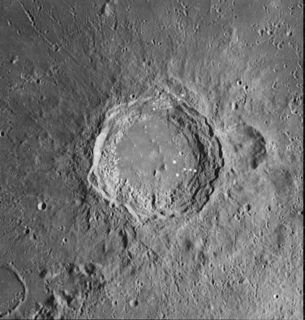 W
WAristoteles is a lunar impact crater that lies near the southern edge of the Mare Frigoris and to the east of the Montes Alpes mountain range. It was officially named in 1935 after the ancient Greek philosopher Aristotle by the International Astronomical Union, using the classical form of his name.
 W
WAtlas is a prominent lunar impact crater that is located in the northeast part of the Moon, to the southeast of Mare Frigoris. Just to the west is the slightly smaller but still prominent crater Hercules. Northeast of Atlas is the large Endymion.
 W
WAutolycus is a lunar impact crater that is located in the southeast part of Mare Imbrium. The crater is named after the ancient Greek astronomer Autolycus of Pitane. West of the formation is Archimedes, a formation more than double the size of Autolycus. Just to the north is Aristillus, and the outer ramparts of these two craters overlap in the intermediate stretch of the lunar mare.
 W
WBaily is the remnant of a lunar impact crater on the boundary between Mare Frigoris to the north and Lacus Mortis to the south. The crater interior has been flooded by lava in the past, and only the northern half of the crater rim remains relatively intact. There is an outward bulge in the northeastern rim, possibly the remnant of another crater formation that once overlapped Baily. The crater interior is flat and relatively featureless, with no impacts of significance. The surviving outer rim reaches a maximum elevation of about 0.5 km.
 W
WBerzelius is a lunar impact crater located in the northeast part of the Moon's near side. It lies to the southeast of the crater Franklin, and to the northwest of Geminus.
 W
WBurckhardt is a lunar impact crater that is located in the northeast part of the Moon. It lies between the craters Geminus just to the north and Cleomedes to the south.
 W
WBürg is a prominent lunar impact crater in the northeast part of the Moon. It lies within the lava-flooded, ruined crater formation designated Lacus Mortis. To the south and southeast is the crater pair Plana and Mason. To the west, beyond the rim of Lacus Mortis, is the prominent crater Eudoxus.
 W
WC. Mayer is a lunar impact crater that is located at the northern edge of the Mare Frigoris, due north of the prominent crater Aristoteles. Also to the south, but only a third as distant, is the smaller crater Sheepshanks. Due east of C. Mayer is the flooded crater Kane.
 W
WCalippus is a small lunar impact crater that is located on the eastern edge of the rugged Montes Caucasus mountain range in the northern part of the Moon. It was named after Greek astronomer Callippus of Cyzicus. It lies to the southwest of the crater remnant Alexander, to the northwest of the Mare Serenitatis.
 W
WCassini is a lunar impact crater that is located in the Palus Nebularum, at the eastern end of Mare Imbrium. The crater was named after astronomers Giovanni Cassini and Jacques Cassini. To the northeast is the Promontorium Agassiz, the southern tip of the Montes Alpes mountain range. South by south-east of Cassini is the crater Theaetetus. To the northwest is the lone peak Mons Piton.
 W
WCepheus is a lunar impact crater that is located in the northeastern part of the Moon, within one crater diameter of the larger crater Franklin to the southeast. To the north-north-east is the flooded crater Oersted. The proximity of this formation to the lunar limb means it appears oblong when viewed from the Earth due to foreshortening.
 W
WChevallier is a lunar impact crater that is located in the northeastern part of the Moon's near side, about a crater diameter east-southeast of the prominent crater Atlas. To the south-southeast of Chevallier is the flooded crater Shuckburgh.
 W
WDaniell is a lunar impact crater located in the southern half of the Lacus Somniorum. To the south-southeast is the much larger crater Posidonius. The Rimae Daniell rille system are to the west of Daniell crater.
 W
WDe La Rue is the remnant of a lunar impact crater, or possibly several merged craters, creating a formation sometimes called a walled plain. It lies in the northeastern part of the Moon on the near side, and so appears foreshortened due to its location. This formation lies to the north-northwest of the prominent crater Endymion, just beyond the eastern extreme of Mare Frigoris. The crater Strabo intrudes into the northern part of De La Rue's northern rim, and the smaller Thales is attached to the northwestern part of the wall.
 W
WDemocritus is a lunar impact crater that is located on the northern part of the Moon, just to the north of the Mare Frigoris. Just to the south of Democritus is the lava-flooded crater Gärtner, which forms a bay on the mare. Directly to the north is Arnold, another flooded formation.
 W
WEgede is the remains of a lunar impact crater that has been flooded by lava, leaving only the somewhat polygonal circumference of the rim protruding just above the mare. It was named after Dano-Norwegian natural historian Hans Egede. It is located on the southern edge of the Mare Frigoris, to the west of the crater Aristoteles. To the southwest is an arc of low mountains curving between the rims of Aristoteles and Eudoxus. The floor of Egede is flat and nearly featureless, except for a few tiny craterlets, including secondaries from Aristoteles. The surviving rim has a maximum altitude of 0.4 km above the surface.
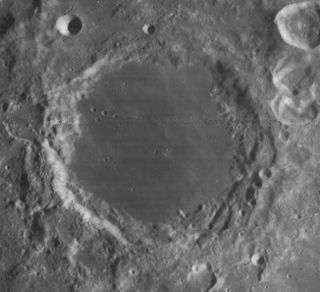 W
WEndymion is a lunar impact crater that lies near the northeast limb of the Moon. It is located to the east of Mare Frigoris, and north of the Lacus Temporis. To the southwest is the somewhat smaller crater Atlas. Because of its location, Endymion has an oval appearance from foreshortening. Beyond the crater along the lunar limb is the Mare Humboldtianum.
 W
WEudoxus is a prominent lunar impact crater that lies to the east of the northern tip of the Montes Caucasus range. It is named after the Greek astronomer Eudoxus of Cnidus. It is located to the south of the prominent crater Aristoteles in the northern regions of the visible Moon. To the south is the ruined formation of Alexander, and the small crater Lamèch lies to the southwest.
 W
WFranklin is a lunar impact crater that is located in the northeast part of the visible Moon; it is named after Benjamin Franklin. To the north-northwest is the smaller crater Cepheus, and in the opposite direction to the southwest is the shallow Berzelius.
 W
WG. Bond is a small lunar impact crater to the south of the Lacus Somniorum, a small lunar mare in the northeast part of the Moon's near side. It was named after the American astronomer George Phillips Bond. It lies to the east of the larger crater Posidonius, and to the south of the flooded crater remnant Hall. The crater is situated in a rugged section of terrain to the northwest of the Montes Taurus mountain region.
 W
WGalle is a small lunar impact crater on the Mare Frigoris, to the north-northeast of the prominent crater Aristoteles. The formation is nearly circular, with a sharp-edged rim and little appearance of erosion. There are slight outward bulges in the rim to the north and northeast, but otherwise the formation is relatively symmetrical.
 W
WGärtner is the lava-flooded remnant of a crater in the northeast part of the Moon. It is located on the northern edge of the Mare Frigoris. The southern half of the formation is completely missing, and Gärtner forms a semi-circular basin along the edges of the lunar mare. To the north lies the crater Democritus.
 W
WGeminus is a lunar impact crater that is located near the northeast limb of the visible Moon. In this position the crater appears oval in shape due to foreshortening, but it is actually more nearly circular in form. Notable nearby craters include Messala to the northeast, Bernoulli due east, and Burckhardt and Cleomedes to the south.
 W
WGrove is a small lunar impact crater that lies in the northern part of the Lacus Somniorum. It is located to the southeast of the crater remnant Mason. Grove is a relatively circular crater formation with a simple, sharp-edged rim. The unconsolidated material along the inner wall has slumped down to the floor, forming a ring around the relatively level base. The floor contains a few tiny impacts, but is otherwise nearly featureless.
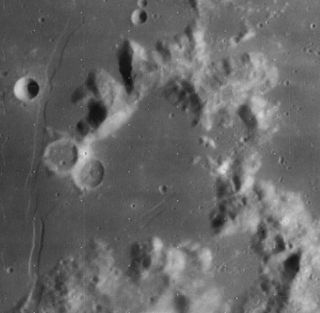 W
WHall is a lunar impact crater in the southeast part of the Lacus Somniorum, a lunar mare in the northeast part of the Moon. It was named after American astronomer Asaph Hall. This feature can be found to the east of the prominent walled plain Posidonius. Just to the south, and nearly attached to the southern rim of Hall is the smaller crater G. Bond.
 W
WHercules is a prominent crater located in the northeast part of the Moon, to the west of the crater Atlas. It lies along the east edge of a southward extension in the Mare Frigoris. To the west across the mare is Bürg. To the south is the ruined crater Williams.
 W
WHooke is a lunar impact crater that is located to the northwest of the crater Messala, in the northeastern part of the Moon. It lies about a crater diameter to the southeast of the comparably sized Shuckburgh.
 W
WKane is the walled remains of a lunar impact crater that has been flooded by lava from Mare Frigoris to the south, and it lies on the northeast edge of this mare. The crater lies midway between the craters C. Mayer to the west and Democritus in the east. To the north-northeast is the crater Moigno.
 W
WKeldysh is a lunar impact crater that is located in the northeastern part of the Moon, at the eastern rim of the Mare Frigoris. It lies due north of the prominent crater Atlas, and to the northeast of the notable Hercules.
 W
WKirchhoff is a small lunar impact crater that is located in the northern part of the Montes Taurus range. It was named after German physicist Gustav Kirchhoff. It lies to the west of the crater Newcomb, and southeast of the crater pair of Hall and G. Bond.
 W
WLacus Mortis is a plain of basaltic lava flows in the northeastern part of the Moon. It lies just to the south of the elongated Mare Frigoris, being separated by a slender arm of rugged ground. To the south is the Lacus Somniorum, separated from this mare by the joined craters Plana and Mason, and a strip of uneven surface.
 W
WLacus Somniorum is a plain located in the northeastern part of the Moon's near side. It is located at selenographic coordinates 38.0° N, 29.2° E, and has a diameter of 384 kilometers. The name is Latin for Lake of Dreams, a title given to this feature by Riccioli.
 W
WLacus Temporis is a small lunar mare that is located in the northeastern quadrant of the Moon's near side. The selenographic coordinates of this feature are 45.9°N 58.4°E, and it lies within a diameter of 117 km.
 W
WLamèch is a small lunar impact crater that is located to the southwest of the prominent crater Eudoxus, at the eastern edge of the Montes Caucasus range. It was named after French selenographer Félix Chemla Lamèch. This is a circular, bowl-shaped formation. The inner walls slope down to a small central floor that is about one-fourth the diameter of the crater. This formation is not notably eroded, and contains no other features of interest.
 W
WLuther is a small lunar impact crater on the northwest part of Mare Serenitatis, at the inlet to Lacus Somniorum. To the east-southeast is the large crater Posidonius. Luther has a circular rim and is cup-shaped, with no appreciable wear from impact erosion. It lies across a wrinkle ridge on the lunar mare.
 W
WMare Frigoris is a lunar mare in the far north of the Moon. It is located in the outer rings of the Procellarum basin, just north of Mare Imbrium, and stretches east to north of Mare Serenitatis. It is just north of the dark crater Plato.
 W
WMason is the remains of a lunar impact crater that lies in the northeastern part of the Moon. It is nearly attached to the eastern rim of the flooded crater Plana, and southeast of Bürg. Along the northern rim of Mason is the southern edge of the Lacus Mortis, a small lunar mare. To the south is the larger Lacus Somniorum.
 W
WMaury is a small lunar impact crater named for two cousins. It was first named in honor of Lieutenant Matthew Fontaine Maury of the U. S. Naval Observatory and later shared to honor Antonia Maury of Harvard College Observatory. The crater lies in the northeastern part of the Moon, just to the east of the Lacus Somniorum. The nearest named craters are Hall to the southwest, and Cepheus farther to the northeast. Just to the west of Maury is the lava-flooded remains of the satellite crater Maury C.
 W
WMessala is a lunar impact crater of sufficient dimension to belong to the category of impact features known as walled plains. It is located in the northeastern part of the Moon, close enough to the rim to appear significantly foreshortened. Nearly attached to the northern rim is the crater Schumacher. To the southwest is the prominent crater Geminus, and due south is the smaller Bernoulli.
 W
WMitchell is a lunar impact crater, which is attached to the eastern rim of the larger and more prominent crater Aristoteles. It was named after American astronomer Maria Mitchell. The floor of Mitchell is rough and irregular, with a low central rise, being partially filled with the ejecta of the younger Aristoteles. There is a slight notch in the southern rim, and the western wall has been completely absorbed by the rim of Aristoteles.
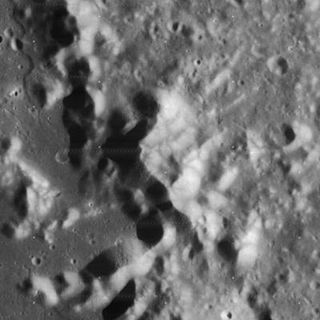 W
WMont Blanc is a mountain in the Montes Alpes range on the Moon. It is located on the western edge of the range, near the shore of Mare Imbrium, at 45.48°N 0.42°E. Its width is about 25 kilometers; the height is 3.7–3.8 km above adjacent plains of Mare Imbrium and 1.12 km above lunar level of zero elevation.
 W
WMontes Caucasus is a rugged range of mountains in the northeastern part of the Moon. It begins at a gap of level surface that joins the Mare Imbrium to the west with the Mare Serenitatis to the east, and extends in an irregular band to the north-northeast to the western side of the prominent crater Eudoxus. The range forms the northwestern boundary of the Mare Serenitatis. It forms a continuation of the Montes Apenninus range to the southwest.
 W
WOersted is a lunar impact crater that has been flooded by lava, leaving only a crescent-shaped rim with a gap to the southwest. The rim climbs to a maximum height of 1.7 km. This feature lies to the southeast of the crater Atlas, and southwest of Chevallier. To the south-southwest is Cepheus.
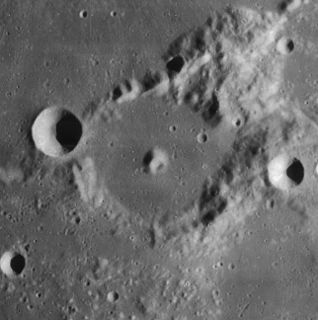 W
WPlana is a lunar impact crater that lies on the boundary between two small lunar mare areas, with Lacus Mortis to the north and the larger Lacus Somniorum on the southern side. It was named after Italian astronomer Giovanni Antonio Amedeo Plana. It is joined to the crater Mason to the east by a short stretch of rugged ground. Due north of Plana in the midst of the Lacus Mortis is the prominent crater Bürg.
 W
WPosidonius is a lunar impact crater that is located on the north-eastern edge of Mare Serenitatis, to the south of Lacus Somniorum. It was named after ancient Greek philosopher and geographer Posidonius of Apamea. The crater Chacornac is attached to the southeast rim, and to the north is Daniell.
 W
WProtagoras is a lunar impact crater that is located on the Mare Frigoris in the northern part of the Moon. To the north-northwest is the slightly larger crater Archytas, and to the southeast is the prominent Aristoteles.
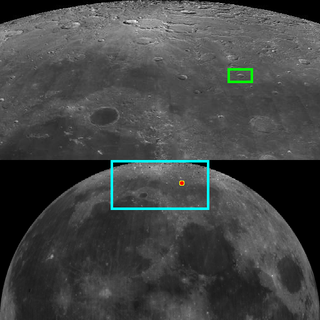 W
WSheepshanks is a small lunar impact crater located near the northern edge of Mare Frigoris. Due south on the opposite shore is the prominent crater Aristoteles while to the north is C. Mayer. Sheepshanks appears somewhat oblong due to foreshortening, but it is actually nearly circular. The inner walls slope down to a ring of material around the inner floor. There is a small craterlet along the southeastern inner wall. The crater is otherwise not particularly eroded by impacts.
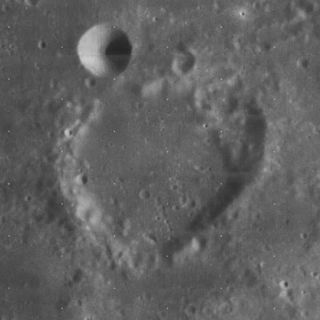 W
WShuckburgh is a lunar impact crater that is located in the northeastern part of the Moon's near side, named after George Shuckburgh-Evelyn. It lies south-southeast of the flooded crater Chevallier and northwest of Hooke, roughly midway between these two formations. To the northeast is the Lacus Temporis plain.
 W
WStrabo is a lunar impact crater that is located near the northeastern rim of the Moon. At this angle the crater appears oval in shape due to foreshortening. It is attached to the north rim of the walled plain De La Rue. To the west is the smaller crater Thales. To the north is a chain of three comparably sized craters designated Strabo L, Strabo B, and Strabo N.
 W
WThales is a small crater located in the northeast part of the Moon, just to the west of the larger crater Strabo. To the southeast is the walled plain De La Rue. Thales has a sharp, circular rim that has received little erosion. The lunar surface around Thales has a ray system that extends for over 600 kilometers, and it is consequently mapped as part of the Copernican System. . An area to the north-northwest of the crater is free of rays, however, indicating that the crater may have been formed by a low-angle impact from that direction. The inner wall has some terraces, particularly along the southern side. The sides have a higher albedo than the typical lunar terrain.
 W
WTheaetetus is a lunar impact crater that is located to the southeast of the crater Cassini near the eastern edge of Mare Imbrium. It was named after the ancient Greek mathematician Theaetetus. It lies just to the west of the Montes Caucasus range, which forms the eastern shore of the mare. To the southwest is the prominent crater Aristillus.
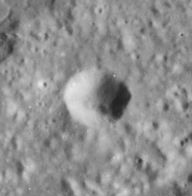 W
WTrouvelot is a lunar impact crater located to the south of the Mare Frigoris. It was named after the French astronomer Étienne Trouvelot. It is a bowl-shaped formation with a higher albedo than its surroundings. The rim is roughly circular, but somewhat uneven. It has not been significantly eroded by subsequent impacts. The crater lies less than 10 kilometers to the south of the Vallis Alpes canyon formation.
 W
WVallis Alpes is a lunar valley feature that bisects the Montes Alpes range. It extends 166 km from the Mare Imbrium basin, trending east-northeast to the edge of the Mare Frigoris. The valley is narrow at both ends and widens to a maximum width of about 10 km along the middle stretch. The selenographic coordinates of the center of this feature are 49.21°N 3.63°E.
 W
WWilliams is the remnant of a lunar impact crater that lies to the south of the prominent crater Hercules, in the northeastern part of the Moon. The southern rim borders the Lacus Somniorum, a small lunar mare that extends to the south and west. To the southwest is the sharp-rimmed crater Grove.